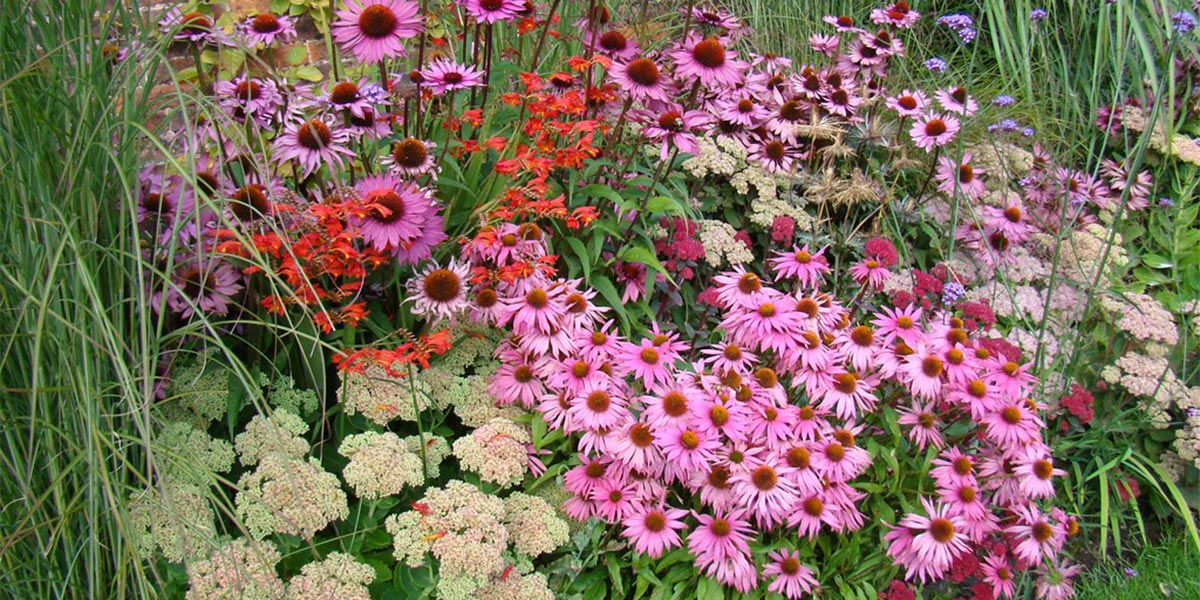Starting into flower after midsummer, late summer perennials fill the garden with colour, often until the first frosts, and sometimes beyond. They work well surrounded by spring bulbs, grasses and earlier-flowering shrubs and perennials for colour in your borders from early spring to late autumn.
Many modern perennials are even better value, flowering for months from early summer onwards. Geranium Dragonheart, with large, black-eyed magenta flowers is a low-growing cranesbill which will wind through and even up into other plants, suppressing weeds and knitting together your planting in the most delightful way. Geranium Rozanne, a bigger cranesbill with blue flowers with white eyes, also flowers for months on end.

Other long-flowering perennials include rudbeckias (cone flowers) with their lovely chrome-yellow daisy flowers. Goldsturm is an excellent cultivar, American Gold Rush is slightly smaller, and Little Goldstar is smaller yet, and particularly floriferous, perhaps the best cultivar for containers. Astrantias or masterworts are also long-flowering in water-retentive soil, with flowers ranging from greenish-white to red; Astrantia Moulin Rouge has perhaps the deepest red flowers of all.

Japanese anemones are taller, graceful stalwarts of the late summer garden, tolerating partial shade and giving up to three months of colour. Deep pink cultivars include double-flowered Pamina and single-flowered Splendens; September Charm has single flowers of a softer pink, and perhaps the most elegant of all is Honorine Jobert, with single, pure white flowers and golden stamens. Japanese anemones tend to run at the root, but the smaller hybrid anemones, like semi-double Ruffled Swan, with pure white flowers with a blue streak on the underside of the petals, are equally beautiful, better-behaved and do best in partial shade.
For the back of a large border, towering Eupatorium maculatum Atropurpureum and the 5’ native hemp agrimony (Eupatorium cannabinum), with their flat heads of rose-purple and purplish-pink flowers respectively, provide months of colour and a feast for bees and butterflies. Long-flowering sedums like Purple Emperor, with its bronze-purple leaves and long-lasting, purplish-red flowers, or Brilliant, with grey-green leaves and bright pinkish-mauve flowers, are also covered with butterflies in late summer. Don’t remove the seed-heads, which provide interesting structure in the winter garden.

For a more formal look, try repeated clumps of agapanthus (African Lily); these are also very good in pots, as they flower best when their roots are rather congested, and this is the best way to grow the evergreen kinds, which are less hardy. There are jazzy bi-coloured ones like blue-and-white Enigma and violet-and-white Twister, or subtle and sophisticated ones like Windsor Grey. Pure white Arctic Star, bright blue Lapis Lazuli and lofty Blue Umbrella (100cm) are evergreen, so do better in pots.
Crocosmias (montbretias) look particularly well planted en masse – try deep red Emberglow, lovely among grasses, or golden-yellow George Davison, which looks great planted with blue salvias or nepetas. Nepetas (catmints), with their grey-green leaves and blue flowers, can bring a welcome coolness to a late summer border, and range from compact Purrsian Blue, very floriferous and long-flowering, to Six Hills Giant, for the larger border. Salvias are also long flowering – try blue Ostfriesland or slightly taller, deep violet-blue Caradonna, with its pink bracts.

And don’t forget warm-season grasses like Miscanthus Yakushima Dwarf (small), Gracillimus and Morning Light, which give airiness and movement to a planting. Their wonderful plumy flowers persist well into winter, and they only need to be cut back in February or early March. Evergreen Stipa gigantea’s golden oat flowers also last well. And remember late-flowering shrubs like hydrangeas, which flower for months and months, and die so very nicely – the leaves often colour well in autumn, and the flowers often change colour as they age. Keep the attractive dead flower-heads on the shrub until the worst of winter is over to protect the new shoots and add an extra dimension to the winter garden. It’s not all over in late autumn!
CLICK HERE to browse our Perennial Collection





